Algae growth is a common problem in ponds and can have a negative impact on the overall health of the ecosystem. Excessive algae can deplete oxygen levels, block sunlight from reaching aquatic plants, and create an unsightly appearance. Fortunately, there are several effective methods for removing algae from a pond and restoring balance to the aquatic environment.

Credit: www.gardengatemagazine.com
1. Manual Removal
One of the simplest ways to control algae growth in a pond is through manual removal. This involves physically removing algae from the water using a net, rake, or other tools. It is important to regularly skim the surface of the pond to prevent algae from multiplying and spreading. Manual removal is a labor-intensive method but can be effective for smaller ponds with manageable algae growth.
2. Biological Control
Introducing natural predators or competitors of algae can help control its growth in a pond. Fish such as koi, goldfish, or grass carp can consume algae and keep its population in check. Additionally, adding aquatic plants like water lilies and water hyacinths can compete with algae for nutrients, limiting its growth. Biological control methods can help maintain a healthy balance in the pond ecosystem.
3. Chemical Treatments
There are various chemical treatments available for controlling algae growth in ponds. Algaecides are chemicals that can be applied to the water to kill algae. It is important to use these products carefully and follow the manufacturer’s instructions to avoid harming other aquatic life in the pond. Copper sulfate and hydrogen peroxide are common algaecides used for treating algae in ponds.
4. Aeration
Aeration is another effective method for controlling algae in ponds. By increasing oxygen levels in the water, aeration can promote the growth of beneficial bacteria that compete with algae for nutrients. Installing a fountain, waterfall, or aerator can help circulate the water and prevent stagnant conditions that favor algae growth. Aeration can improve water quality and reduce algae blooms in the pond.

Credit: www.wikihow.com
5. Shading
Reducing sunlight exposure can inhibit algae growth in a pond. Installing shade sails, floating plants, or artificial structures can help create shaded areas in the pond. Limiting sunlight penetration can prevent algae from photosynthesizing and reproducing rapidly. Shading is a natural method for controlling algae that can be combined with other strategies for effective results.
6. Nutrient Control
Algae thrive on nutrients like nitrogen and phosphorus present in the water. Controlling nutrient levels can help prevent excessive algae growth in a pond. Avoid overfeeding fish, reduce runoff from fertilizers or organic matter, and maintain a balanced ecosystem to limit nutrient availability for algae. Nutrient control is a proactive approach to managing algae in ponds.
7. Regular Maintenance
Consistent pond maintenance is essential for preventing algae overgrowth. Regularly inspect the pond for signs of algae, test water quality parameters, and remove debris that can contribute to nutrient buildup. By staying proactive and addressing algae growth early, you can prevent larger issues and maintain a healthy pond environment. Regular maintenance is key to long-term algae control.
Conclusion
Algae removal in a pond requires a combination of strategies tailored to the specific conditions of the ecosystem. Whether through manual removal, biological control, chemical treatments, aeration, shading, nutrient control, or regular maintenance, there are several effective methods for managing algae growth and restoring balance to the pond. By implementing these techniques and monitoring the pond’s health, you can enjoy a clear, healthy aquatic environment free from excessive algae.


